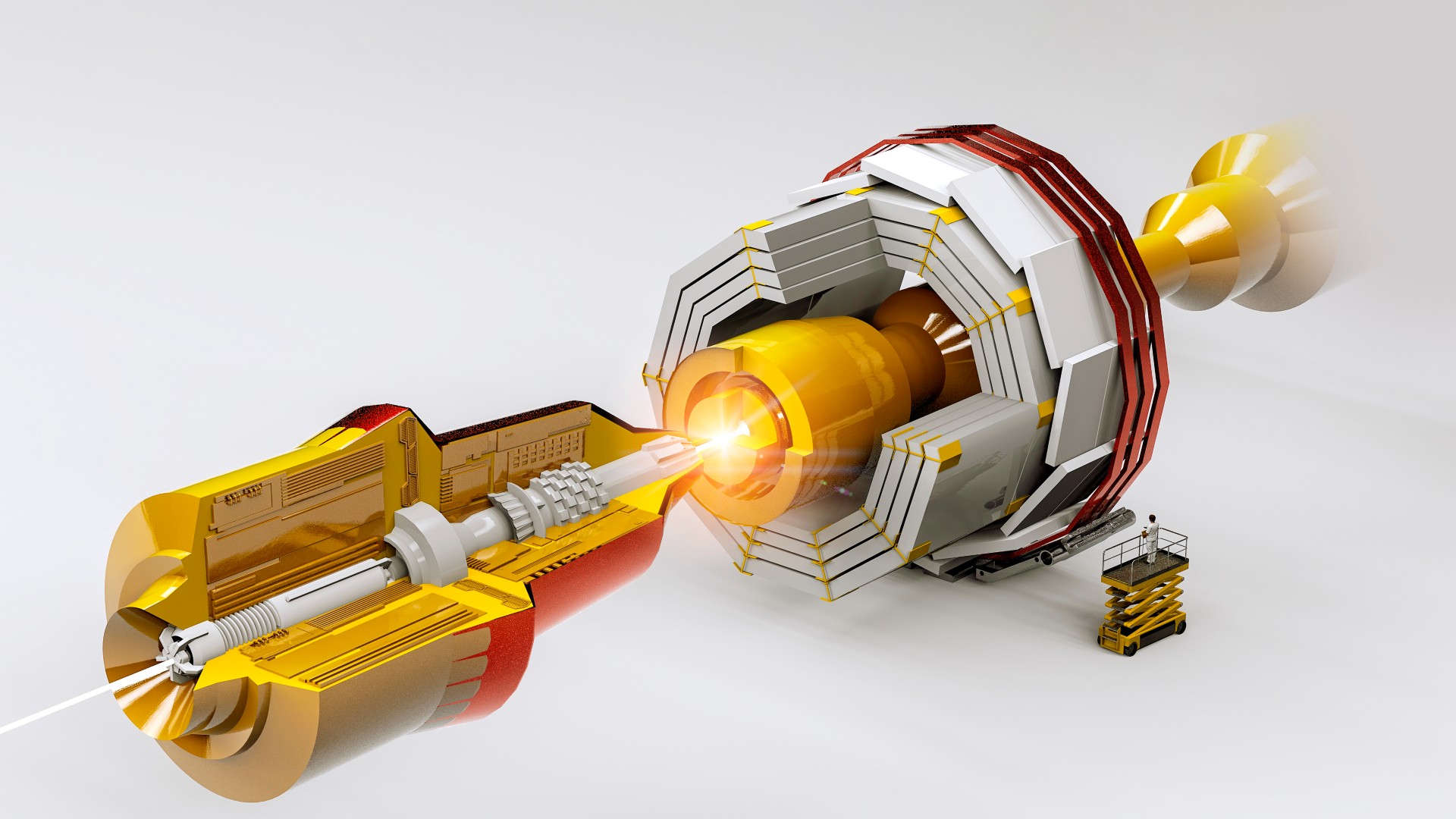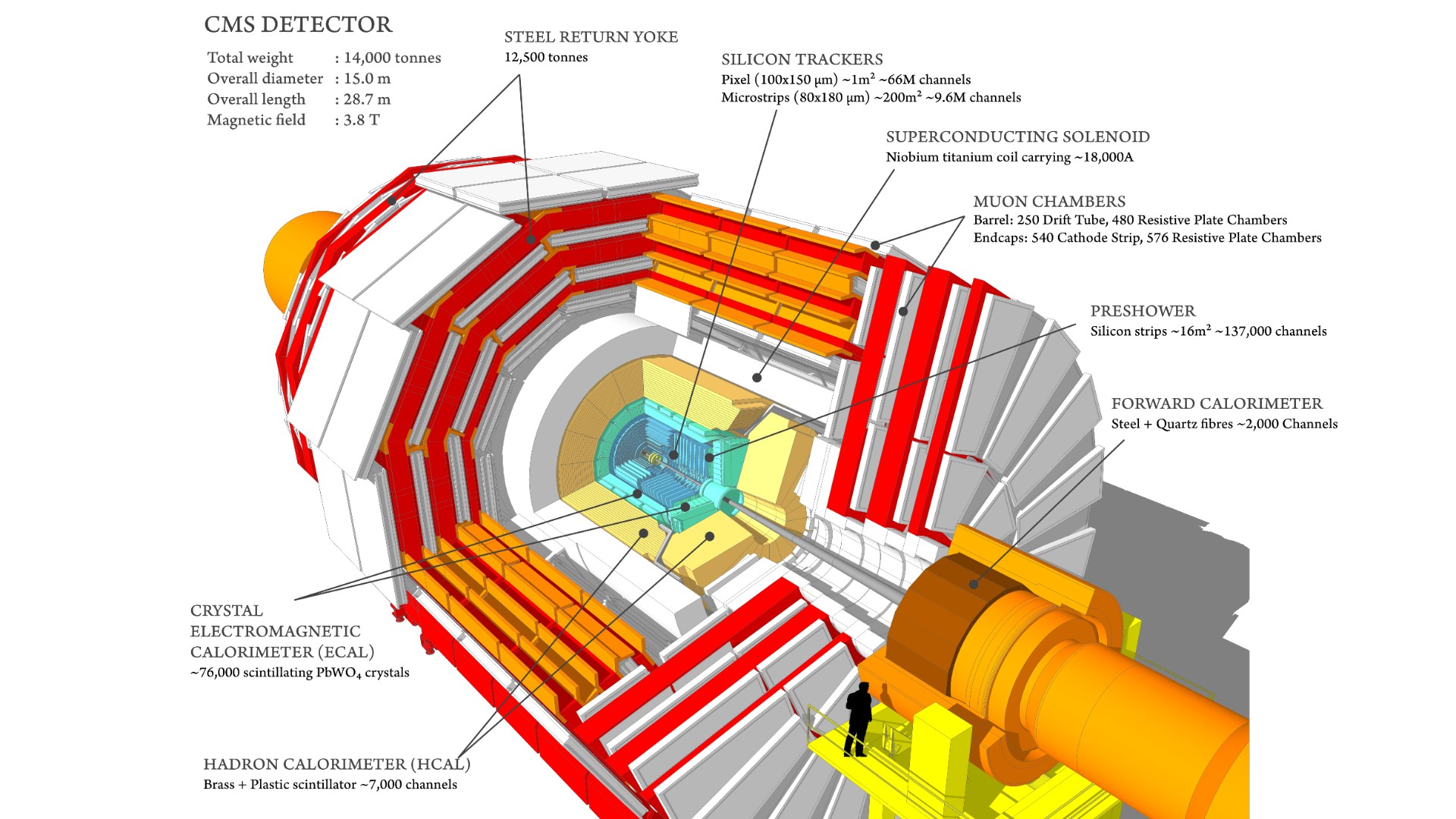What is the Compact Muon Solenoid experiment?
The Large Hadron Collider's Compact Muon Solenoid played a key role in discovering the Higgs boson.

The CMS, or Compact Muon Solenoid, experiment is a particle detector at the Large Hadron Collider (LHC), the world's largest particle accelerator. The LHC, which is operated by the European Organization for Nuclear Research (CERN) and sits at the border of Switzerland and France, accelerates particle beams to nearly the speed of light, smashes them into each other and then tries to decipher the short-lived particles that form as a result, using detectors like the CMS.
In fact, it was detectors like the CMS that played a large role in the discovery of the Higgs boson in 2012.
Here's a detailed look at one of the detectors involved in the Higgs discovery, the CMS experiment.
Compact Muon Solenoid
The basic purpose of the CMS, and the LHC's other detectors like ATLAS, is to capture as much information as possible about the particles created in high-energy collisions in the LHC's massive, 17-mile-long (27 kilometers) underground ring, according to CERN. These particles would normally fly out from the central collision point in straight lines. But at the LHC, strong magnets curve the paths of particles with electric charge. By measuring the detailed shape of a particle's path, scientists can work out its charge and momentum, which gives insight into what type of particle was briefly created.
In the case of the CMS, a massive electromagnet called a solenoid generates a magnetic field around 100,000 times as strong as Earth's. This solenoid is made up of a cylindrical coil of superconducting fibers through which 18,500 amperes of electric current passes, according to CERN.
It's this magnet — the largest solenoid ever constructed — that provides the third word in the CMS' name. The first word, "compact," may seem odd given the huge size of the magnet, but it's a relative term. At 49 feet (15 meters) high and 69 feet (21 m) long, the detector really is quite compact for all the scientific equipment it packs. The middle word, "muon," refers to a heavy, charged elementary particle that the CMS is designed to detect very accurately. Muons are heavier relatives of the electron, which are important because they can be produced in the decay of several elusive particles including the Higgs boson.
The CMS detector

Together with the ATLAS experiment, the CMS is one of two general-purpose detectors located inside the LHC, according to CERN. CMS and ATLAS have the same scientific goals, but they employ different magnets and technical systems. Like ATLAS, the CMS is located at one of the LHC's intersection points, in a cavern 328 feet (100 m) belowground. But it's on the opposite side of the collider, which puts it in a different country. Whereas ATLAS is located near Meyrin, Switzerland, the CMS is closer to Cessy, France. Also, ATLAS was built and assembled in its cavern, but the CMS was constructed in 15 sections at ground level before being lowered to its final position.
Get the world’s most fascinating discoveries delivered straight to your inbox.
The CMS is akin to a giant 3D camera, according to CERN, snapping up to 40 million images of particle collisions, from all directions, every second. It takes the form of a nested series of concentric cylinders, each with a different task to perform, wrapped around the central collision point. Near the middle are silicon trackers, containing around 75 million individual electronic sensors, which can record the curved paths traced out by charged particles. Farther out, a series of calorimeters measures the energy of particles thrown out in collisions. Finally, the outer layer of the detector is where the elusive muons are observed, using specially designed "muon chambers."
CMS physics
Although the CMS is physically located in France, from a scientific point of view, it's a global facility. As with ATLAS, the CMS experiment is a collaborative enterprise bringing together members of the scientific community from all over the world, according to CERN. The collaboration involves more than 4,000 physicists and engineers from about 200 universities and other institutions in over 40 countries. In June 2020, the CMS collaboration published its 1,000th peer-reviewed research paper, according to the Fermi National Accelerator Laboratory, which is one of the facilities involved in the collaboration.
A thousand papers is an amazing achievement — even more so because the LHC only started operating in 2009. Undoubtedly the high point so far was CMS this paper, which laid out the experiment's contribution to the discovery of the Higgs boson. Predicted to exist as far back as the 1960s, this particle had eluded the world's supercolliders for decades due to its large mass and fleeting existence.
Only once the LHC began running did collision energies become high enough to create the Higgs. The search finally ended in 2012, according to CERN, with a formal announcement on July 4 of that year that both the CMS and ATLAS had detected the Higgs particle with a significance of "5 sigma," a statistical term meaning there was less than a 1-in-a-million chance the detection was caused by random fluctuations.
As those thousand papers testify, the Higgs discovery was far from the end of the road for the CMS. When the LHC turns back on in April 2022, the CMS experiment will play a central role in trying to answer some of the biggest questions in physics, including what dark matter is made of and whether other spatial dimensions may exist, according to CERN.
Additional resources
- Explore the CMS experiment website.
- Watch a video about the Compact Muon Solenoid on YouTube.
- View hundreds of CMS images on CERN's document server.
Bibliography
CERN. (n.d.). CMS. Retrieved March 16, 2022, from https://home.web.cern.ch/science/experiments/cms
CERN. (n.d.). How a detector works. Retrieved March 16, 2022, from https://home.web.cern.ch/science/experiments/how-detector-works
CMS Experiment. (n.d.). Collaboration. CERN. Retrieved March 16, 2022, from https://cms.cern/collaboration
CMS Experiment. (n.d.). Detector. CERN. Retrieved March 16, 2022, from https://cms.cern/detector
Gray, H., & Mansoulié, B. (2018, July 4). The Higgs boson: the hunt, the discovery, the study and some future perspectives. ATLAS Experiment, CERN. https://atlas-public.web.cern.ch/updates/feature/higgs-boson
Wetzel, J. (2020, June 24). CMS collaboration publishes 1,000th paper. Fermi National Accelerator Laboratory, U.S. Department of Energy. https://news.fnal.gov/2020/06/cms-collaboration-publishes-1000th-paper-2/

Andrew May holds a Ph.D. in astrophysics from Manchester University, U.K. For 30 years, he worked in the academic, government and private sectors, before becoming a science writer where he has written for Fortean Times, How It Works, All About Space, BBC Science Focus, among others. He has also written a selection of books including Cosmic Impact and Astrobiology: The Search for Life Elsewhere in the Universe, published by Icon Books.
 Live Science Plus
Live Science Plus






